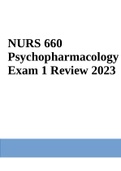Exam (elaborations)
THIS EXAM STUDY GUIDE INCLUDES questions and Answers with Explanations vSim for Nursing: Fundamentals: Vernon Russell Vsim for Nursing: Post Quiz- Edith Jacobson Post Quiz- Jared Griffin Mr. Griffin Pre-Simulation vSim Quiz
- Institution
- Rasmussen College
THIS EXAM STUDY GUIDE INCLUDES questions and Answers with Explanations vSim for Nursing: Fundamentals: Vernon Russell Vsim for Nursing: Post Quiz- Edith Jacobson Post Quiz- Jared Griffin Mr. Griffin Pre-Simulation vSim Quiz
[Show more]












